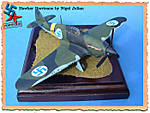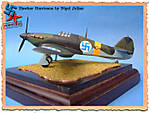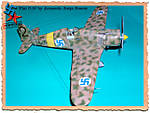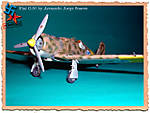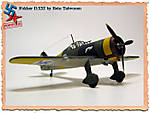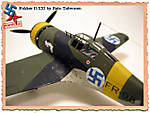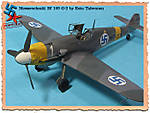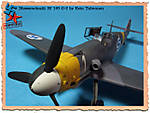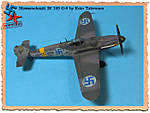1⁄35Fighters Under the Midnight Sun
4
Comments

The only Soviet strategic attack which failed was against Finland. Of WWII European combatants, only Finland and Great Britain were never occupied. Part of Finland's success of holding off the Soviet monster was her independent air force, the Suomen Ilmavoimat (Finnish Air Force), which boasts the world’s highest scoring non-Luftwaffe or Japanese aces. In the Winter War the VVS (Soviet Air Force) commenced their air attacks against Finland in November 1939 with 3,253 aircraft, while the Ilmavoimat possessed only 36 Fokker D.XXIs and 10 Bristol Bulldogs to oppose the Soviet attack! The Continuation War began with another communist assault on 25 June 1941 and ended with an armistice on 4 September 1944. Ilmavoimat claimed 1807 kills with Finnish flak downing another 1345; Ilmavoimat lost 257 aircraft in action and another 315 to training and non-operational events. Extraordinarily, recent research into Russian archives reveal the Soviets credited 1855 of their losses to Finnish fighter pilots.
Before the Second World War, Finland, like many countries, followed the ideas of the air power theorist Giulio Douhet, who believed that strategic bombings with heavy, fast, high-altitude bombers would be the future way of aerial warfare. Because of this so called “Douhetism”, the development of fighters lagged behind bomber aircraft all the way until late 30’s and It was the Winter War that made the fighter the primary weapon in the Finnish Air Force.
When the war broke out in November 1939, the majority of planes operated by the Finnish Air Force were already obsolete. The much-published aid from abroad didn’t help much, consisting mainly of aging aircraft types (a good example of this is the Gloster Gladiator, of which England donated 10 to Finland, with the obligation of buying further 20). The only modern type was Fiat G.50, although the more numerous Fokker D.XXI is considered the best fighter in FAF service during the Winter War. Another peculiar characteristic of FAF was the multitude of aircraft types in service. This not only made maintenance more difficult, but also problematic was the fact that several aircraft types used machine gun ammunition of the same caliber that were not compatible with each other.
Despite the inferior equipment and being outnumbered by 10 to 1, Finnish Air Force was able to achieve incredible results against the enemy. One achievement that well symbolizes the sheer determination of the Finnish defenders is 6th of January 1940, when Lt. Jorma Sarvanto made the unofficial world record by shooting down six bombers from a formation of seven, the last spared only because he ran out of ammo. Their stunning performance against the VVS was due not to equity in numbers or even quality of equipment, but in ground breaking tactics and doctrine employed with excellent training. In the early 1930s the fighter arm's father, LTC Richard Lorentz experimented with, and implemented, the dual two plane basic formation that the nascent Luftwaffe eventually adopted as the Schwarm. Later, Capt. Gustaf Erik Magnusson toured several of the world's air forces, spending time with the Luftwaffe's new JG 132. The German adoption of the Schwarm convinced the FAF their tactics were sound. Lacking money for training, Ilmavoimat taught just three tactics of attack and emphasized gunnery. Pilots were ordered not to fire beyond 50 m!
After the conflict ended the 13th of March, Finnish Air Force had shot down 218 Russian planes according to the official FAF statistics. Recent Soviet sources acknowledge between 261 to 579 Soviet losses, 207 claimed air-to-air. The Ilmavoimat lost just 23 fighters in action.
During the brief period of interim peace before the Continuation War, which was to begin in June 1941, the shortcomings in the Air Force were clear and newer planes were purchased. The most important type was the B-239 Brewster which was the main fighter aircraft when the war started, the first of which arrived nearing the end the Winter War, but were too late to see any action. Other planes bought from abroad included Hawker Hurricanes from England (Finns did allegedly attempt to purchase Spitfires as well, but the Brits were understandably reluctant to part with state of the art aircraft while the war against Germany was at full swing) and war booty Curtiss Hawks and Morane Saulniers bought from Germany.
When the Soviet Union attacked Finland 25th of June 1941 after provoked by Germany being allowed to use Finnish territory in launching the Operation Barbarossa and Hitler declaring Finland to be fighting alongside (“Im bunde”) with Germany, VVS commenced numerous air attacks, the Finnish Air Force countering the attacks by shooting down 23 planes without casualties. It came clear that the better planes, tactics, and lessons learnt from the Winter War were put into use with full effect. During the first two weeks of the war, FAF managed to shoot down 68 enemy planes and losing only one Fokker fighter.
During the attack phase of the war, fighters covered attacking troops and bombers harassed clusters of enemy troops and convoys. The very successful aerial battles fought usually ensured Finnish air superiority, the pilot with most kills during this time being Chief Warrant Officer Oiva Tuominen with 18 downed enemy planes, the majority achieved flying a Fiat fighter.
By the year 1943, it had been ever clearer that the plane types operated by FAF were getting old and obsolete compared to the Russian arsenal, Finnish pilot prevailing because of their superior flying skills and training. To remedy this, modern Messerschmitt Bf-109 fighters and Junkers Ju-88 bombers were bought from Germany.
With the newer equipment, FAF was able to fight the ever more advanced planes fielded by VVS and help hold back the Fourth Strategic Offensive, started in conjunction with the Allied Normandy invasion in July 1944. During the offensive, Finland managed to purchase more Bf-109G fighters and were also helped by the German flight detachment Kuhlmey (and a half-strength assault gun brigade and an infantry division).
This newer equipment purchased helped Finnish pilots rack up their scores even further in the summer of 1944. Many pilots achieved the status of ace flying Bf-109G’s and those already experienced added even more downed planes to their accounts. The most successful non-German pilot of all time, Ilmari Juutilainen achieved the score of 94 without a single hit by enemy fighters. Other prominent aces include Hans "Hasse" Wind (75 official victories), Eino Luukkanen with a score of 56 and Urho Lehtovaara (44½).
All in all, the success of the Finnish air arm can be explained with good tactics, superior training, knowing the pros and cons of what was available and making the most of every piece of equipment. (The Finns maintained what would surely have been scrapped in other countries, resulting in some airframes getting high numbers of kills. A good example being BW-393, it’s 41 kills making it possibly the highest-scoring airframe of all time.
Another thing worth mentioning is how good results the Finns made with aircraft shunned by other countries, Brewster Buffalo being the most prominent example of this. Considered a failure by almost all other users, it was loved by Finnish pilots and was the main fighter in the Air Force until the introduction of the Bf-109’s.
But no matter how good the planes are, the skills of the pilots flying them is what matters the most, and this is well represented in the kill/loss ratio of Finnish fighters. Messerschmitt pilots shot down 663 VVS planes while losing 21 of their own, while 447 enemy planes were downed with Brewsters with only 19 planes lost.
Finland’s valiant stand against communist fascism is little known in the annals of the Twentieth Century. It is yet another shining example of how a free, democratic, small, motivated country with good tactics and doctrine can prevail in the face of seemingly overwhelming brutal regimes.
Text: Eetu Tahvonen and Fred Rick Boucher
Models by Fred Rick Boucher, Brian Fendley, Jean-Luc Formery, Nigel Julian, Frank Portela, Hermon Rector, Armando Jorge Soares and Eetu Tahvonen.
Sources:
http://fi.wikipedia.org/wiki/Talvisota (in Finnish)
http://fi.wikipedia.org/wiki/Jatkosota (in Finnish)
http://www.veteraanienperinto.fi/suomi/Kertomukset/sotilas/sotilas/talvisota/luutnantti_sarvannon_taistelulen.htm (in Finnish)
http://www.veteraanienperinto.fi/suomi/t_pankki/a_lajit/lentajan_maailmanennatys.htm (in Finnish)
http://en.wikipedia.org/wiki/Fighter_ace
http://en.wikipedia.org/wiki/Fourth_strategic_offensive
http://en.wikipedia.org/wiki/Ilmari_Juutilainen
http://en.wikipedia.org/wiki/Hans_Wind
http://en.wikipedia.org/wiki/Eino_Luukkanen
http://en.wikipedia.org/wiki/Urho_Lehtovaara
http://en.wikipedia.org/wiki/Battle_of_Tali-Ihantala
http://en.wikipedia.org/wiki/Brewster_Buffalo
Comments
Great work people, just great! Awesome models! Tell me, what do you know about the Swedish volunteers F-19 that took part in the winter war, did they score any kills?
JAN 26, 2007 - 04:22 PM
I couldn't agree more!
Regarding F-19, I did a quick search and came up with these:
http://www.sci.fi/~fta/f19-1.htm
http://www.canit.se/~griffon/aviation/text/f19.htm
JAN 26, 2007 - 05:45 PM
Fantastic work!! What a great themed portfolio that seems to be very well researched. You are a true expert.
Thanks for sharing!
FEB 11, 2007 - 06:04 PM
Copyright ©2021 by Eetu Tahvonen. Images also by copyright holder unless otherwise noted. The views and opinions expressed herein are solely the views and opinions of the authors and/or contributors to this Web site and do not necessarily represent the views and/or opinions of AeroScale, KitMaker Network, or Silver Star Enterrpises. Images also by copyright holder unless otherwise noted. Opinions expressed are those of the author(s) and not necessarily those of AeroScale. All rights reserved. Originally published on: 2007-01-27 00:00:00. Unique Reads: 9198






